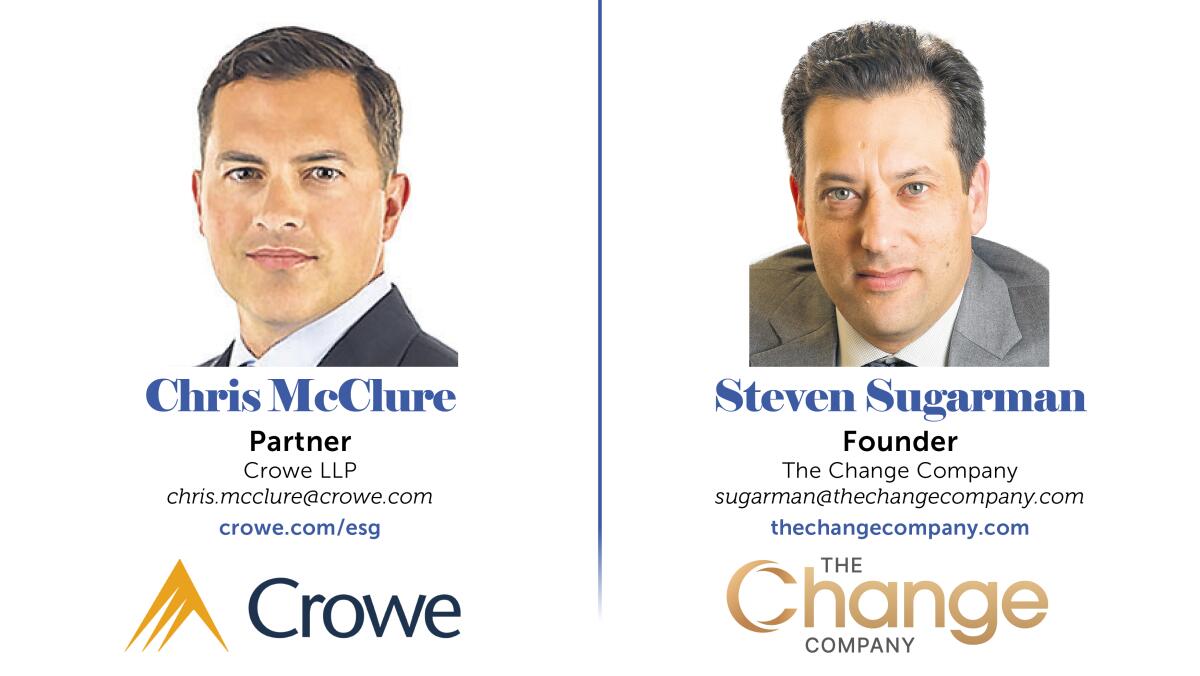Chris McClure and Steven Sugarman Give Insights on Environmental, Social & Governance (ESG) Investing

The ESG Investing panel is produced by the L.A. Times B2B Publishing team in conjunction with The Change Company and Crowe LLP.
Perhaps more prevalent than any other trend in the corporate space today, environmental and social has become a mainstay for businesses seeking investor, shareholder and public support. Amid public sector initiatives to achieve the objectives of the Paris Climate Agreement, there has been a sharp growth in investors’ use of environmental, social and governance (ESG) approaches to integrate climate risks and opportunities into investment decisions.
While noteworthy progress has been made across most industries, some challenges and unknowns resulting f rom the COVID-19 pandemic have made the road to “doing the right thing” more complex.
To explore the impacts leading up to and resulting f rom the ESG movement and to get a deeper understanding of the investment and corporate perspectives of ESG transparency, we turned to two of the region’s trusted advisors and experts, who graciously weighed in for a discussion and shared insights and forecasts of what to expect f rom this powerful focus everyone is talking about.
Q: Do you feel the “invest in ESG” trend is likely to continue growing steadily for years to come?

Steven Sugarman, Founder, The Change Company: We believe “invest in ESG” is more than a “trend,” which suggests something fleeting. Good corporate citizenship is a critical component of the enterprise value of any company. As a new generation of investors begin to make their voice heard, attention to environmental, social, and various governance issues will only continue to grow. Double bottom line businesses like ours will become the norm, rather than the exception.
Q: Is the state of California more ESG-focused than other regions? How do ESG practices differ in other regions?

Chris McClure, Partner, Crowe LLP: In the United States, the state of California has been a recognized leader in many aspects of ESG for quite some time, especially f rom a regulatory perspective. One example is the California Transparency in Supply Chains Act of 2010, which established novel requirements for companies doing business in California, including conducting due diligence on supply chains to mitigate the risks of human trafficking and other labor violations. In another example, Proposition 65 requires businesses to provide product warning labels to Californians about significant exposures to chemicals that cause cancer, birth defects, or other reproductive harm. And finally, California currently is evaluating the Climate Corporate Accountability Act (SB 260), which, if passed into law, will require corporations with more than $1 billion in annual revenue to report all scopes of their greenhouse gas (GHG) emissions to the California secretary of state.
Q: Looking to the future, what do you envision aiding and/or impeding the continuation of the recent upward trajectory in impact finance? How do you predict it will it develop?
Sugarman: The greatest risk to impact finance and at the same time, the most effective way to encourage impact investing, would be for regulators and policymakers to recognize the implications of their actions. If ESG becomes synonymous with symbolic gestures, rather than serious, longterm commitments to structural change, consumers and investors will grow cynical. If regulators and policymakers can correct these unintended consequences and empower impact finance to provide fair, equitable and consistent results, then companies will build longterm business plans that maximize impact, and it will continue to grow at an accelerated pace. The demand is there - the supply needs to keep up.
“ESG leadership must come from the C-suite and be supported by a cross-functional team of specialists throughout the organization.”
— Chris McClure
Q: When it comes to ESG, what are some common risks that companies should avoid, and how can they avoid them?
McClure: Improper execution of ESG reporting carries many risks. The most common problem is “greenwashing,” which refers to cherry-picking selected topics and only reporting the narrative a company finds favorable. There’s a growing risk that solely positive ESG stories could be diminished or questioned by industry research and by corporate benchmarking by activists and nongovernmental organizations. Lax ESG reporting could confuse - or worse, contradict - regulatory disclosures. Poor or limited materiality assessments and stakeholder engagement might neglect key topics and performance indicators. Lack of communication among ESG leaders within an organization could yield incorrect data and erroneous disclosures. All these risks might lead to reputational and financial harm. The good news is that they can be avoided by implementing ESG with a thoughtful, practical, and comprehensive approach.
Sugarman: One of the biggest risks is focusing only on the “E” in ESG. The ESG movement is about improving the world broadly. The “S” is every bit or even more important. The way to avoid that risk is to be bold in your commitments and to find partners that are in the field helping address our biggest social challenges, like the racial wealth gap. CDFIs are one such partner, delivering $75 billion in loans annually, which directly contributed to the creation of over 1.5 million jobs, enabling the start-up of more than 400,000 small businesses and microenterprises, and allowing for the rehabilitation of more than two million housing units. Those are the types of tangible results companies should seek when building their ESG programs.
In what ways are corporate ESG disclosures beneficial?
McClure: ESG initiatives play a crucial role in how a business embraces the values of its customers, investors, employees, management, and other key stakeholders. Corporate ESG disclosures highlight the ways in which an organization is addressing the nonfinancial imperatives it faces - from environmental management and employee retention to transparency in governance and data privacy. These critical issues affect consumer sentiment and investor decisions as well as the overall reputation of the company. ESG disclosures offer an organization the chance to demonstrate that it measures success in ways that go beyond financial statements and earnings per share. These disclosures also provide guidance and leadership to an entire industry and help shape the ways in which the business community does well by doing good.
“The data is clear – customers want to do business with companies that are making a positive impact and investors want to back those companies, too.”
— Steven Sugarman
What are the key benefits for businesses that implement ESG initiatives?
Sugarman: ESG initiatives are not only important for the positive impact they create - they are also good business. The data is clear - customers want to do business with companies that are making a positive impact and investors want to back those companies, too. Indeed, studies show that commitment to ESG correlates to improved stock prices.
McClure: ESG initiatives are playing an increasingly important role in how businesses embrace the values of their customers, investors, employees, management, and other key stakeholders. Businesses should properly identify their material ESG topics and craft road maps to design, implement, and execute on a plan for data-driven, verifiable disclosures. Proper measurement and disclosure can communicate important nonfinancial information about the company that can drive new growth and help it stand apart from its peer group. If done correctly, these initiatives can benefit employee and community relations while communicating important information to potential investors and customers.
What are some key areas of focus to consider for companies as they consider enhancing social sustainability?
Sugarman: One area that needs more attention is the persistent wealth gap in the U.S. While companies are talking a lot about DEI, which is laudable, they aren’t making a meaningful difference in terms of racial equity if they aren’t somehow helping close that gap. The hard truth is that the homeownership gap is greater than it was 100 years ago. Community Development Financial Institutions (CDFIs) sit on the frontlines of this issue, serving low-income and minority communities where support is needed most. Investing in CDFIs is one way companies can contribute to addressing this deep-rooted challenge.
“There’s a growing risk that solely positive ESG stories could be diminished or questioned by industry research and by corporate benchmarking by activists and nongovernmental organizations.”
— Chris McClure
Are there potential legal and liability issues to consider for companies considering ESG initiatives?
McClure: Yes, early on, companies should engage their legal counsel as a key voice in overall ESG planning to address any number of risks. Many ESG initiatives require companies to create policies, procedures, and codes of conduct that affect the organizations’ employees, suppliers, and vendors. These policies must be thoughtful and lawful to ensure they protect the personnel subject to them. Questions about or violations of the policies also might require legal involvement to manage and resolve disputes. ESG disclosures can create a risk of liability if they are poorly written, contain incorrect information, or are deemed misleading to investors. Some initiatives require the collection of potentially privileged or sensitive data from employees and suppliers that must be properly protected. Compliance with regulatory ESG disclosure requirements should always involve legal counsel to ensure timely and factual responses and filings to avoid penalties and fines.
Who at a company should take a leadership role in terms of initiating ESG programs, and who else should be on the team?
McClure: ESG programs and disclosures must be thoughtfully designed, properly implemented, and rigorously managed. Accurate data sourced from systems and procedures with verifiable controls is a must. ESG leadership must come from the C-suite and be supported by a cross-functional team of specialists throughout the organization. Legal, sustainability, compliance and risk, supply chain, environmental, health and safety, human resources, information technology, and finance are some of the key participants. Internal audit is playing a growing role in validating data, processes, and controls. Investor relations and the mergers and acquisition group should have input regarding future expansion and how transactions could affect requirements. The sales team might have insights into customer expectations around ESG metrics. All these areas can be supplemented by external providers who can offer market and regulatory updates as well as best practices to confirm that the team is addressing the full scope of ESG.
“A strong ESG program can help to attract and retain quality, mission-driven employees, increasing the profitability and impact of the business.”
— Steven Sugarman
Is ESG something of value only to companies in specific industries?
Sugarman: ESG principles can be valuable to every company. A strong ESG program can help to attract and retain quality, mission-driven employees, increasing the profitability and impact of the business. This can benefit investors, regulators, and other stakeholders.
McClure: This is a great question and one that we’ve discussed in detail with colleagues who work in various industries. Our conversations have established that the broad nature of ESG and the trends toward measurement and disclosure affect all industries. ESG is top of mind across the board. Each industry has topics that are important to its key stakeholders, and most are feeling increased pressure from peer groups, employees, consumers, and customers to address ESG concerns. The Sustainability Accounting Standards Board has worked for several years to offer detailed reporting templates by industry. At last count, there are more than 70 different guidance reports detailed by industry and subindustry. Influential pension funds and private equity investors are embracing ESG metrics, a trend whose impact is felt across all industries. Similarly, U.S. regulations at the local, state, and federal levels are driving increased disclosures.
What’s one thing that you hope our readers will take into account when considering ESG investing?
Sugarman: Focus on the “S” in ESG. Improving society and addressing structural issues that have impeded progress is the central purpose of ESG investing. Look for companies that are tackling the most entrenched social issues we face. In America, that inevitably means finding companies that are not just paying lip service to racial equity and justice but companies, like CDFIs, that are actually closing the wealth gap and finally righting some of the historic wrongs that led to that wealth gap in the first place.